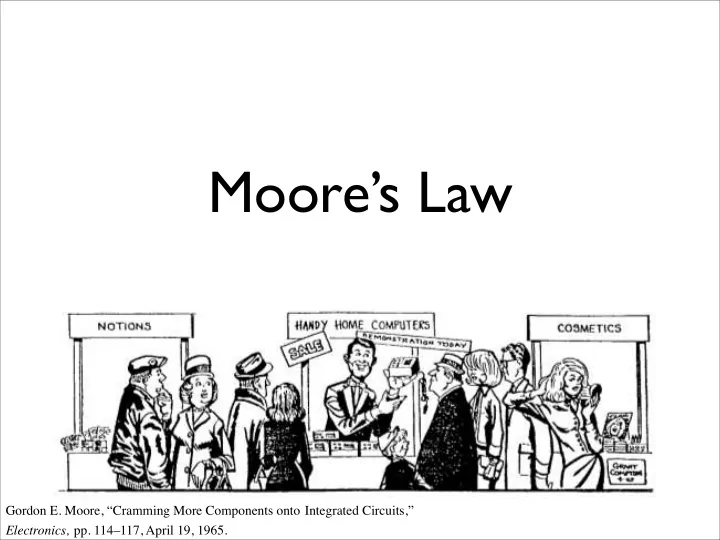

Moore’s Law Gordon E. Moore, “Cramming More Components onto Integrated Circuits,” Electronics, pp. 114–117, April 19, 1965.
Cramming More Components onto Integrated Circuits • A manifesto about the promise of integrations • Gordon Moore predicts a huge range of applications • And a bunch of advantages • He’s selling hard!
The promise • Apps -- scientific advancement, home computers, automatic auto control, cell phones, electronic wrist watches, large scale data processing, and communication networks.
The Promise • Reliability • Compactness • Weight • Power efficiency • Simpler designs -- see 8008 to 8086 evolution
Moore’s Law • The number of minimum cost xtrs per die increases exponentially • Density decreases cost • Yield problems increases cost
Moore’s Law • xtrs count double s every year. • Not quite right • Moore’s law: 2 50 xtrs in 2009 • Reality: 2 32 • Probably fewer “cheapest”
How it played out
Moore’s Law • Since 1975 • 1,100 x decrease in feature size • 1.2M x increase in density • About 45% per year. Doubling every 22 months.
Observations • Other components (caps, inductors) will be elusive. • Constant power scaling (formalized by Dennard) • Chip size is roughly constant • Moore says 1/4 sq. in. = 161mm 2
Observations • Very optimistic about reliability. • Electron beam lithography (this is still just a few years away) • Multiple metal layers!!! • Other technologies • attaching active components to “thin film arrays”
Corollaries to Moore’s Law • Moore’s law performance scaling • Switching speed goes up with decreasing feature sizes -- Moore doesn’t comment on this. • We have leveraged density + switching speed to increase performance roughly with Moore’s law.
Performance Growth Performance grows faster than Moore’s law (45%/year) An In-Depth Look at Computer Performance Growth, Magnus Ekman, Fredrik Warg, and Jim Nilsson, CHALMERS UNIVERSITY OF TECHNOLOGY, Department of Computer Engineering technical report 2004-9, 2004.
Beating Moore An In-Depth Look at Computer Performance Growth, Magnus Ekman, Fredrik Warg, and Jim Nilsson, CHALMERS UNIVERSITY OF TECHNOLOGY, Department of Computer Engineering technical report 2004-9, 2004.
In Context • It’s hard to overestimate the importance of the impact of Moore’s law. • However... • Note that it’s not about performance. • It’s strictly about density. • Not that this stops anyone from abusing it. • A pretty compelling vision for what integrated circuit could do.
More on Scaling • Seminal paper on scaling is Dennard et. al. “Design of ion-implanted MOSFET's with very small physical dimensions”, 1974 • Lays out how to truly scalable transistors.
Dennardian Scaling • Given a scaling factor k. drain sink L Gate W tox Oxide Substrate
Dennardian Breakdown • The problem with leakage 2000 4 Energy * Delay @ Vt = 300mV 3.5 1500 relative leakage 3 1000 2.5 2 500 1.5 0 1 0 0.2 0.4 0.6 0.8 1 2 3 4 5 6 7 8 Vt Vdd/Vt
Dennardian Breakdown
Dennardian Breakdown
Recommend
More recommend